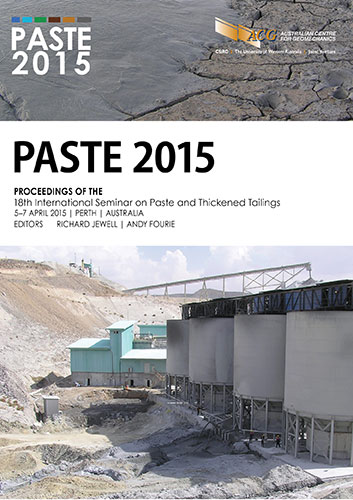Practical observations in beach slope formation and application of the thin layer equilibrium model to observed data

|
Authors: Wates, JA; Venter, HA; Dittle, VT; Cooper, RA |
DOI https://doi.org/10.36487/ACG_rep/1504_34_Wates
Cite As:
Wates, JA, Venter, HA, Dittle, VT & Cooper, RA 2015, 'Practical observations in beach slope formation and application of the thin layer equilibrium model to observed data', in R Jewell & AB Fourie (eds), Paste 2015: Proceedings of the 18th International Seminar on Paste and Thickened Tailings, Australian Centre for Geomechanics, Perth, pp. 443-453, https://doi.org/10.36487/ACG_rep/1504_34_Wates
Abstract:
Prediction of the beach slopes for green fields projects is difficult and there is little consensus on the best method to use to make the predictions. The time has now come to collect data for actual beach slopes and to establish some empirical relationships that can be used by practitioners to ‘ground truth’ their predictions. This paper presents the results of observations of beach slopes that have been developed in the field under different circumstances and establishes a relationship that the authors have used for practical verification of predictions. The main drivers of beach slope have been found to be flow rate and yield stress. Flow rate however can be eliminated as one of the key variables where the discharge energy can be effectively dissipated close to the discharge point or where the tailings surface is large enough to ensure that the flowing tailings eventually stalls and fans out to form fluvial beaches. In most instances for high rates of discharge the surface area of the tailings facilities is not large enough to meet the latter condition particularly in the early stages of basin development when the surface area is small and flow is concentrated. In order to maximise beach slope the discharge rate must therefore be reduced by splitting the flow in smaller streams. The surficial thin layer beach slope model that is proposed in the paper assumes that discharge energy can be dissipated by splitting the flow into no more than 3,000 tpd per point and is then based on the hypothesis that the beach is formed when the tailings stalls rather than when it is flowing in the channels that are so often observed on beaches. These observations are usually made when viewed from the discharge end of the beach since this is usually the easiest point to access. The tailings is usually flowing when the observation is made and the authors will argue that this therefore does not represent the conditions under which beaches form but rather the condition that pertains to transport the tailings across the foundation beach. This hypothesis leads to the theory that at the point of stalling it is only the aerial dimensions, thickness and yield stress that determine the slope at which the tailings will come to rest. This hypothesis applies only to non-segregating tailings slurries. The paper presents the results of the observations made by the authors and describes the physical conditions of flow that have been observed in practice at the point in time that the tailings stalls. The paper is intended to be more practical than theoretical but will refer to the surficial thin layer model to illustrate how variations in the parameters that can be controlled by an operator influence beaching.
References:
Greenwood, JR & Holt, DA 1985, ‘Shallow slips in highway embankments of cover constructed clay’, Proceedings of the Symposium on Failures in Earthworks, Thomas Telford Ltd, London, pp. 79-92.
Landriault, D 2002, ’10.5 Bulyanhulu Mine, Tanzania’, in RJ Jewell, RB Fourie & ER Lord (eds), Paste and Thickened Tailings – A Guide (First Edition), Australian Centre for Geomechanics, Perth.
Wates, JA & Fourie, AB 1993, ‘Surficial sloughing of embankments: a case history’, Journal of the South African Institution of Civil Engineers, vol. 35, no. 3, pp. 16-20.
Wates, JA, Welff, RN & Thieriault, JR 2003, ‘Surface paste disposal at Bulyahulu’, Proceedings of the Third international conference on mining and industrial waste management, Geotechnical and Environmental Divisions of the South African Institution of Civil Engineers, Johannesburg.
Wates JA, Venter, HA, O’Callaghan, A & Tucker, J 2014, ‘The influence of feed properties on cyclone performance and stacking of underflow’, in RJ Jewell, AB Fourie, PS Wells & D van Zyl (eds), Proceedings of the 17th international seminar on paste and thickened tailings, InfoMine Inc., Vancouver, pp. 445-458.
© Copyright 2025, Australian Centre for Geomechanics (ACG), The University of Western Australia. All rights reserved.
View copyright/legal information
Please direct any queries or error reports to repository-acg@uwa.edu.au
View copyright/legal information
Please direct any queries or error reports to repository-acg@uwa.edu.au